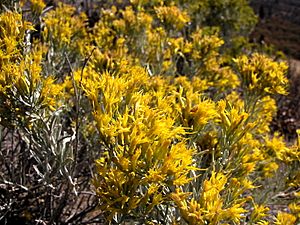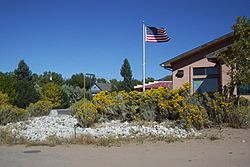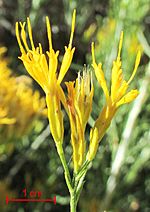Ericameria nauseosa facts for kids
Quick facts for kids Ericameria nauseosa |
|
|---|---|
 |
|
| Ericameria nauseosa in Oregon | |
| Scientific classification | |
| Kingdom: | |
| (unranked): | |
| (unranked): | |
| (unranked): | |
| Order: | |
| Family: | |
| Tribe: |
Astereae
|
| Genus: |
Ericameria
|
| Species: |
E. nauseosa
|
| Binomial name | |
| Ericameria nauseosa (Pall. ex Pursh) G.L.Nesom & G.I.Baird
|
|
| Synonyms | |
|
Synonymy
Chondrophora nauseosa (Pall. ex Pursh) Britton
Chrysothamnus nauseosus (Pall. ex Pursh) Britton Chrysocoma nauseosa]] Pall. Chrysothamnus frigidus Greene Bigelowia nauseosa M.E.Jones Chrysothamnus collinus Greene Chrysothamnus concolor (A.Nelson) Rydb. Chrysothamnus pallidus A.Nelson Aster edwardii Kuntze Bigelowia juncea Greene Chrysothamnus junceus (Greene) Greene Chrysothamnus plattensis (Greene) Greene Machaeranthera scabrella (Greene) Shinners, syn of var. ammophila Aster binominatus Kuntze, syn of var. bigelovii Bigelowia bigelovii (A.Gray) A.Gray, syn of var. bigelovii Chrysothamnus bigelovii (A.Gray) Greene, syn of var. bigelovii Chrysothamnus glareosus (M.E.Jones) Rydb., syn of var. bigelovii Chrysothamnus moquianus Greene, syn of var. bigelovii Linosyris bigelovii A.Gray, syn of var. bigelovii Bigelowia ceruminosa (Durand & Hilg.) A.Gray, syn of var. ceruminosa Chrysothamnus ceruminosus (Durand & Hilg.) Greene, syn of var. ceruminosa Linosyris ceruminosus Durand & Hilg., syn of var. ceruminosa Chrysothamnus angustus Greene, syn of var. consimilis Chrysothamnus confinis Greene, syn of var. consimilis Chrysothamnus consimilis Greene, syn of var. consimilis Chrysothamnus falcatus Greene, syn of var. consimilis Chrysothamnus patens Rydb. syn of var. consimilis Chrysothamnus pinifolius Greene, syn of var. consimilis Chrysothamnus tortuosus Greene, syn of var. consimilis Bigelowia graveolens (Nutt.) A.Gray, syn of var. graveolens Chrysocoma graveolens Nutt., syn of var. graveolens Chrysothamnus dracunculoides (DC.) Nutt., syn of var. graveolens Chrysothamnus graveolens (Nutt.) Greene, syn of var. graveolens Chrysothamnus laetevirens Greene, syn of var. graveolens Chrysothamnus virens Greene, syn of var. graveolens Linosyris graveolens (Nutt.) Torr. & A.Gray, syn of var. graveolens Chrysothamnus gnaphalodes (Greene) Greene, syn of var. hololeuca Chrysothamnus appendiculatus (Eastw.) A.Heller, syn of var. latisquamea Chrysothamnus arizonicus (Greene) Greene, syn of var. latisquamea Chrysothamnus latisquameus (A.Gray) Greene, syn of var. leiosperma Aster leiospermus (A.Gray) Kuntze, syn of var. leiosperma Bigelowia leiosperma A.Gray, syn of var. leiosperma Chrysothamnus leiospermus (A.Gray) Greene, syn of var. leiosperma Aster mohavensis (Greene) Kuntze, syn of var. mohavensis Bigelowia mohavensis Greene, syn of var. mohavensis Bigelowia mohavensis Greene ex A.Gray, syn of var. mohavensis Chrysothamnus mohavensis (Greene) Greene, syn of var. mohavensis Bigelowia glareosa M.E.Jones, syn of var. psilocarpa Chrysothamnus salicifolius Rydb., syn of var. salicifolia Chrysothamnus californicus Greene, syn of var. speciosa |
|

Ericameria nauseosa (formerly Chrysothamnus nauseosus), commonly known as Chamisa, rubber rabbitbrush, and gray rabbitbrush, is a North American shrub in the sunflower family (Aster). It grows in the arid regions of western Canada, western United States (from the western Great Plains to the Pacific) and northern Mexico.
Two subspecies have been described, nauseosa (the gray form with 14 varieties) and consimilis (the green form with 8 varieties).
Rubber rabbitbrush was moved from the genus Chrysothamnus to the genus Ericameria in a 1993 paper. The findings of a 2003 phylogenetic investigation of Ericameria were consistent with the move of the rubber rabbitbrush from Chrysothamnus to Ericameria. The second edition of the Jepson plant manual and the USDA Germplasm Resources Information Network have adopted the name Ericameria nauseosa.
Contents
Description
Growth pattern
Ericameria nauseosa is a 2' to 8' perennial shrub. The shrub reproduces from seeds and root sprouts.
Inflorescence
It blooms from August to October. It produces pungent-smelling, golden-yellow flowers. Flower heads are made up of 5 small, yellow, tubular disk flowers, and occur in umbrella-shaped terminal clusters.
Stems and leaves
Leaves, depending on the subspecies, are long and narrow to spatula-shaped. Both the flexible (rubbery) stems and the leaves are greenish-gray with a soft felt-like covering.
Subspecies and varieties
Recognized infraspecific taxa from The Plant List with distribution information from Flora of North America and Tropicos
- Ericameria nauseosa subsp. consimilis (Greene) G.L.Nesom & G.I.Baird (green form)
- Ericameria nauseosa var. arenaria (L.C.Anderson) G.L.Nesom & G.I.Baird – sandstone in Arizona, New Mexico, Utah
- Ericameria nauseosa var. arta (A.Nelson) G.L.Nesom & G.I.Baird – Idaho, Oregon
- Ericameria nauseosa var. ceruminosa (Durand & Hilg.) G.L.Nesom & G.I.Baird – gravelly arroyos in Mohave Desert of California
- Ericameria nauseosa var. juncea (Greene) G.L.Nesom & G.I.Baird – Utah
- Ericameria nauseosa var. leiosperma (A.Gray) G.L.Nesom & G.I.Baird – sandy + rocky sites in Arizona, California, Colorado, Nevada, Utah
- Ericameria nauseosa var. mohavensis (Greene) G.L.Nesom & G.I.Baird – scrublands in California, Nevada
- Ericameria nauseosa var. nitida (L.C.Anderson) G.L.Nesom & G.I.Baird – dry streambeds in Arizona, New Mexico, Utah
- Ericameria nauseosa var. turbinata (M.E.Jones) G.L.Nesom & G.I.Baird – sand dunes in Arizona, Nevada, Utah
- Ericameria nauseosa subsp. nauseosa (gray form)
- Ericameria nauseosa var. ammophila L.C.Anderson – Colorado
- Ericameria nauseosa var. bernardina (H.M.Hall) G.L.Nesom & G.I.Baird – open pine forests in California; Baja California
- Ericameria nauseosa var. bigelovii (A.Gray) G.L.Nesom & G.I.Baird – dry slopes in Arizona, Colorado, New Mexico, Utah
- Ericameria nauseosa var. graveolens (Nutt.) Reveal & Schuyler – plains in Sask.; Arizona, Colorado, Idaho, Kansas, Montana, Nebraska, Nevada, New Mexico, Dakotas, Oklahoma, Texas, Utah, Wyoming
- Ericameria nauseosa var. hololeuca (A.Gray) G.L.Nesom & G.I.Baird – slopes in Arizona, California, Idaho, Nevada, New Mexico, Oregon, Utah
- Ericameria nauseosa var. iridis (L.C.Anderson) G.L.Nesom & G.I.Baird – steep, barren slopes in Sevier County in Utah
- Ericameria nauseosa var. latisquamea (A.Gray) G.L.Nesom & G.I.Baird - dry streambeds in Arizona, New Mexico; Baja California, Sonora
- Ericameria nauseosa var. nana (Cronquist) G.L.Nesom & G.I.Baird – ridges and cliffs in Idaho, Oregon, Washington
- Ericameria nauseosa var. nauseosa – plains + hills in Alberta, Saskatchewan; Colorado, Idaho, Montana, Nebraska, Dakotas., Wyoming
- Ericameria nauseosa var. oreophila (A.Nelson) G.L.Nesom & G.I.Baird – Arizona, California, Colorado, Idaho, Montana, Nevada, New Mexico, Oregon, Utah, Wyoming, Baja California
- Ericameria nauseosa var. psilocarpa (S.F.Blake) G.L.Nesom & G.I.Baird – sagebrush scrub in eastern Utah
- Ericameria nauseosa var. salicifolia (Rydb.) G.L.Nesom & G.I.Baird – brushlands in Utah
- Ericameria nauseosa var. speciosa (Nutt.) G.L.Nesom & G.I.Baird – brush + open woodlands in Alberta, British Columbia, California, Colorado, Idaho, Montana, Nevada, Oregon, Utah, Washington, Wyoming
- Ericameria nauseosa var. texensis (L.C.Anderson) G.L.Nesom & G.I.Baird – Guadalupe Mountains in Texas + New Mexico
- Ericameria nauseosa var. washoensis (L.C.Anderson) G.L.Nesom & G.I.Baird – open rocky sites in grasslands of northeastern California and northwestern Nevada
Cultivation
Rabbitbrush, Ericameria nauseosa, has gained popularity as an ornamental xeriscaping shrub in areas where water conservation is important. It thrives in a wide range of coarse, alkaline soils that are common to desert environments. Pruning the shrub back to several inches in early spring, before new growth begins, may help improve the shrub's ornamental value.
Forage
Along with associated species, like big sage and western wheat grass, rubber rabbitbrush is a significant source of food for browsing wildlife (including game animals and rabbits) on winter ranges. Dense stands of this species often grow on poorly managed rangelands, in disturbed areas along roadways and on abandoned agricultural property.
Uses
The Zuni people use the blossoms bigelovii variety of the nauseosa subspecies to make a yellow dye. They use the stems to make baskets.
Possible commercial uses
Rubber rabbitbrush was considered as a source of rubber as early as 1904. Several studies have been conducted on the possible use of rubber rabbitbrush as a source of rubber including ones during World Wars I and II, and 1987. Currently the University of Nevada is conducting research on possible of uses of rubber rabbitbrush for biomaterial and bioenergy uses. One possible commercial use of rubber rabbitbrush would be as a source for hypoallergenic rubber for use in products designed for people with latex allergies.
Radioactivity
Specimens growing in Bayo Canyon, near Los Alamos, New Mexico, exhibit a concentration of radioactive strontium-90 300,000 times higher than a normal plant. Their roots reach into a closed nuclear waste treatment area, mistaking strontium for calcium due to its similar chemical properties. The radioactive shrubs are "indistinguishable from other shrubs without a Geiger counter."
Gallery
-
Rabbitbrush native to the area near the post office in Crestone, Colorado
Images for kids






